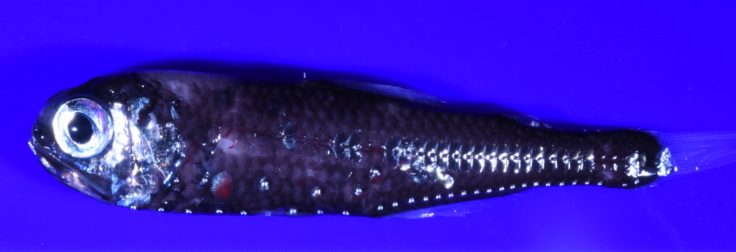Study hints at how fishes in the twilight zone evolved
A new study, led by British Antarctic Survey and the University of Bristol, provides the first evidence that a controversial evolutionary process may be responsible for lanternfishes becoming one of the most diverse families of fish in the deep sea.
Lanternfish are small, bioluminescent – meaning they give off light – fishes, present in every ocean around the world. They live between the surface and 1000m deep within the so-called “twilight zone”, and in the Southern Ocean, they are a major consumer of krill – small, shrimp-like creatures – and are an important food source for king penguins and elephant seals.

There are around 250 species of lanternfish in the oceans, but scientists don’t know how this group of fishes came to be so diverse.
Typically, new species form after a population becomes geographically isolated – by a mountain range or waterway, for example. However, the ocean is vast and unchanging over large areas, and many marine animals can move freely over large distances. By studying lanternfish, researchers hope to understand more about diversity in the ocean.
Researchers brought together historical records, created maps of lanternfish distributions and analysed genetic information to help them understand more about how species diversify in the open ocean.
Using more than 60,000 historical records, the scientists created distribution maps for 161 species. They found that many lanternfish species have circumglobal distributions – meaning they are found in oceans around the world – whereas others are restricted to small areas with particular ocean conditions.
The scientists then reconstructed the evolutionary relationship between 175 lanternfish species, using around 1000 DNA sequences. By combining these relationships with the distribution maps, the researchers found that closely related species are more likely to overlap in their distribution, compared to species that are more distantly related. This means it is unlikely that geographic isolation was the cause of species diversification.
Dr Jen Freer, a marine ecologist at British Antarctic Survey and lead author on the study says:
“This is a really exciting and important finding, because it’s the first global evidence to support the idea of speciation without strict geographical isolation for these fishes. This research is helping us understand more about how species have diversified in the open ocean at a global scale, and also shows how there’s still much more to learn about the evolution of these fishes.”

Prof. Martin Genner from the University of Bristol, who co-authored the study, says:
“Lanternfishes are one of the most diverse and ecologically important groups of marine fishes. This study shows that the ancestral lanternfish species have divided into multiple species with overlapping distributions. It shows us how the vast species diversity in the sea could have evolved without geographic barriers splitting populations. This idea remains a controversial biological process, so the insights provided by lanternfishes are extremely valuable for our understanding of evolution.”
Future research is now needed to look closely at the potential factors that allowed sister species to diverge.
Freer, J., Collins, R.A., Tarling, G.A., Collins, M.A., Partridge, J.C., and Genner. M.J., (2022). Global phylogeography of hyperdiverse lanternfishes indicates sympatric speciation in the deep sea. Global Ecology and Biogeography herehttps://onlinelibrary.wiley.com/doi/10.1111/geb.13586